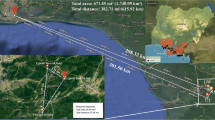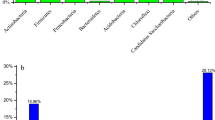Abstract
Petroleum contamination is a severe threat to the soil environment. Previous studies have demonstrated that petroleum degradation efficiency is promoted by enhancing soil moisture content (MC). However, the effects of MC on soil microbial ecological functions during bioremediation remain unclear. Here, we investigated the impacts of 5% and 15% of moisture contents on petroleum degradation, soil microbial structures and functions, and the related genes using high-throughput sequencing and gene function prediction. Results indicated that petroleum biodegradation efficiency was increased by 8.06% in the soils with 15% MC when compared to that with 5% of MC. The complexity and stability of soil microbial community structures with 15% MC were higher than those in the soils with 5% MC when hydrocarbon-degrading bacterial flora (HDBF) were inoculated into the soils. Fifteen percent of moisture content strengthened the interaction of the bacterial community network and reduced the loss of some key bacteria species including Mycobacterium, Sphingomonas, and Gemmatimonas. Some downregulated gene pathways relating to bioaugmentation were enhanced in the soils with 15% MC. The results suggested that the dynamic balances of microbial communities and the metabolic interactions by 15% MC treatment are the driving forces for the enhancement of bioremediation in petroleum-contaminated soil.







Similar content being viewed by others
References
Ma MY, Chen Y, Su RD, Liu Z, He JK, Zhou WZ, Gu MX, Yan ML, Qian L (2022) In situ synthesis of Fe-N co-doped carbonaceous nanocomposites using biogas residue as an effective persulfate activator for remediation of aged petroleum contaminated soils. J Hazardous Mater 435:128963
Song B, Tang J, Zhen M, Liu XM (2019) Effect of rhamnolipids on enhanced anaerobic degradation of petroleum hydrocarbons in nitrate and sulfate sediments. Sci Total Environ 678:438–447
Mehetre GT, Dastager SG, Dharne MS (2019) Biodegradation of mixed polycyclic aromatic hydrocarbons by pure and mixed cultures of biosurfactant producing thermophilic and thermo-tolerant bacteria. Sci Total Environ 679:52–60
Marro N, Cofré N, Grilli G, Alvarez C, Labuckas D, Maestri D, Urcelay C (2020) Soybean yield, protein content and oil quality in response to interaction of arbuscular mycorrhizal fungi and native microbial populations from mono- and rotation-cropped soils. Appl Soil Ecol 152:103575
Shahi A, Aydin S, Ince B, Ince O (2016) Reconstruction of bacterial community structure and variation for enhanced petroleum hydrocarbons degradation through biostimulation of oil contaminated soil. Chem Eng J 306:60–66
Roy AS, Baruah R, Borah M, Singh AK, Deka Boruah HP, Saikia N, Deka M, Dutta N, Chandra Bora T (2014) Bioremediation potential of native hydrocarbon degrading bacterial strains in crude oil contaminated soil under microcosm study. Int Biodeterior Biodegrad 94:79–89
Catania V, Lopresti F, Cappello S, Scaffaro R, Quatrini P (2020) Innovative, ecofriendly biosorbent-biodegrading biofilms for bioremediation of oil- contaminated water. New Biotechnol 58:25–31
Quintella CM, Mata AMT, Lima LCP (2019) Overview of bioremediation with technology assessment and emphasis on fungal bioremediation of oil contaminated soils. J Environ Manag 241:156–166
Abbasian F, Palanisami T, Megharaj M, Naidu R, Lockington R, Ramadass K (2016) Microbial diversity and hydrocarbon degrading gene capacity of a crude oil field soil as determined by metagenomics analysis. Biotechnol Prog 32:638–647
Ferradji FZ, Mnif S, Badis A, Rebbani S, Fodil D, Eddouaouda K, Sayadi S (2014) Naphthalene and crude oil degradation by biosurfactant producing Streptomyces spp. isolated from Mitidja plain soil (North of Algeria). Int Biodeterior Biodegrad 86:300–308
Muangchinda C, Srisuwankarn P, Boubpha S, Chavanich S, Pinyakong O (2020) The effect of bioaugmentation with Exiguobacterium sp. AO-11 on crude oil removal and the bacterial community in sediment microcosms, and the development of a liquid ready-to-use inoculum. Chemosphere 250:126303
Poi G, Ball AS, Aburto-Medina A, Mok PC, Ball AS, Shahsavari E (2017) Large scale bioaugmentation of soil contaminated with petroleum hydrocarbons using a mixed microbial consortium. Ecol Eng 102:64–71
Nwankwegu AS, Onwosi CO (2016) Bioremediation of gasoline contaminated agricultural soil by bioaugmentation. Environ Technol Innov 7:1–11
Shi K, Zhang Q, Xue J, Chen X, Sun J (2020) Study on the degradation performance and bacterial community of bioaugmentation in petroleum-pollution seawater. J Environ Chem Eng 8:103900
Czarny J, Staninska-Pięta J, Piotrowska-Cyplik A, Juzwa W, Wolniewicz A, Marecik R, Ławniczak Ł, Chrzanowski Ł (2020) Acinetobacter sp. as the key player in diesel oil degrading community exposed to PAHs and heavy metals. J Hazard Mater 383:121168
Gao H, Wu ML, Liu H, Xu YR, Liu ZL (2022) Effect of petroleum hydrocarbon pollution levels on the soil microecosystem and ecological function. Environ Pollut 15:118511
Gielnik A, Pechaud Y, Huguenot D, Cébron A, Esposito G, van Hullebusch ED (2020) Functional potential of sewage sludge digestate microbes to degrade aliphatic hydrocarbons during bioremediation of a petroleum hydrocarbons contaminated soil. J Environ Manag 2020:111648
Méndez V, Fuentes S, Hernández M, Morgante V, González M, Seeger M (2010) Isolation of hydrocarbon-degrading heavy-metal-resistant bacteria from crude oil-contaminated soil in central chile. J Biotechnol 150:287
Almansoory AF, Hasan HA, Abdullah SRS, Idris M, Anuar N, Al-Adiwish WM (2019) Biosurfactant produced by the hydrocarbon-degrading bacteria: characterization, activity and applications in removing TPH from contaminated soil. Environ Technol Innov 14:100347
Ebadi A, Khoshkholgh Sima NA, Olamaee M, Hashemi M, Ghorbani Nasrabadi R (2018) Remediation of saline soils contaminated with crude oil using the halophyte Salicornia persica in conjunction with hydrocarbon-degrading bacteria. J Environ Manag 219:260–268
Aini IN, Ezrin MH, Aimrun W (2014) Relationship between soil apparent electrical conductivity and pH value of Jawa series in oil palm plantation. Agricult Agricult Sci Proc 2:199–206
Kavdir Y, Killi D (2008) Influence of olive oil solid waste applications on soil pH, electrical conductivity, soil nitrogen transformations, carbon content and aggregate stability. Bioresour Technol 99:2326–2332
Kavdir Y, Killi D (2008) Influence of olive oil solid waste applications on soil pH, electrical conductivity, soil nitrogen transformations, carbon content and aggregate stability. Bioresour Technol 99:2326–2332
Preece C, Verbruggen E, Liu L, Weedon JT, Peñuelas J (2019) Effects of past and current drought on the composition and diversity of soil microbial communities. Soil Biol Biochem 131:28–39
Hong JK, Jho EH, Choi HS, Kang G (2018) Role of hemoglobin in hemoglobin-based remediation of the crude oil-contaminated soil. Sci Total Environ 627:1174–1181
Deng Q, Cheng X, Hui D, Zhang Q, Li M, Zhang Q (2016) Soil microbial community and its interaction with soil carbon and nitrogen dynamics following afforestation in central China. Sci Total Environ 541:230–237
Rowley MC, Grand S, Verrecchia ÉP (2018) Calcium-mediated stabilisation of soil organic carbon. Biogeochemistry 137:27–49
Zhou LY, Zhou XH, Shao JJ, Nie YY, He YH, Jiang LL, Wu ZT, Bai SH (2016) Interactive effects of global change factors on soil respiration and its components: a meta-analysis. Global Change Biol 22:3157–3169
Das S, Richards BK, Hanley KL, Krounbi L, Walter MF, Walter MT, Steenhuis TS, Lehmann J (2019) Lower mineralizability of soil carbon with higher legacy soil moisture. Soil Biol Biochem 130:94–104
Ibrahim HMM (2016) Characterization of biosurfactants produced by novel strains of Ochrobactrum anthropi HM-1 and Citrobacter freundii HM-2 from used engine oil-contaminated soil. Egyptian J Petrol 27:21–29
Wu ML, Wu J, Zhang X, Ye X (2019) Effect of bioaugmentation and biostimulation on hydrocarbon degradation and microbial community composition in petroleum-contaminated loessal soil. Chemosphere 237:124456
Varjani S, Upasani VN, Pandey A (2020) Bioremediation of oily sludge polluted soil employing a novel strain of Pseudomonas aeruginosa and phytotoxicity of petroleum hydrocarbons for seed germination. Sci Total Environ 737:139766
Ramadass K, Megharaj M, Venkateswarlu K, Naidu R (2018) Bioavailability of weathered hydrocarbons in engine oil-contaminated soil: impact of bioaugmentation mediated by Pseudomonas spp. on bioremediation. Sci Total Environ 636:968–974
Sharma S, Pandey LM (2020) Production of biosurfactant by Bacillus subtilis RSL-2 isolated from sludge and biosurfactant mediated degradation of oil. Bioresour Technol 307:123261
Wang S, Wang X, Han X, Deng Y (2018a) Higher precipitation strengthens the microbial interactions in semi-arid grassland soils. Global Ecol Biogeogr 27:570–580
Tran KN, Jang S-H, Lee C (2021) Effect of active-site aromatic residues Tyr or Phe on activity and stability of glucose 6-phosphate dehydrogenase from psychrophilic Arctic bacterium Sphingomonas sp. Biochimica et Biophysica Acta (BBA) – Proteins Proteom 1869:140543
Chen YA, Grace LPW, Whang LM, Wu YJ, Cheng SS (2020) Effect of soil organic matter on petroleum hydrocarbon degradation in diesel/fuel oil-contaminated soil. J Biosci Bioeng 129:603–612
Zhao T, Gao Y, Yu T, Zhang Y, Zhang Z, Zhang L, Zhang LJ (2021) Biodegradation of phenol by a highly tolerant strain Rhodococcus ruber C1: biochemical characterization and comparative genome analysis. Ecotoxicol Environ Safety 208:111709
Song C, Li M, Qi H, Zhang Y, Liu D, Xia X, Pan H, Xi B (2018) Impact of anti-acidification microbial consortium on carbohydrate metabolism of key microbes during food waste composting. Bioresour Technol 259:1–9
Zhou JH, Tang JJ, Gao RR, Liu ZQ, Cheng H, Yuan YH, Fan HB (2019) Effects of soil moisture on microbial activity in oil-contaminated soil. J Nanchang Inst Technol 38(6):28–32
Chaudhary DK, Bajagain R, Jeong SW, Kim J (2019) Biodegradation of diesel oil and n-alkanes (C 18, C20, and C 22) by a novel strain Acinetobacter sp. K-6 in unsaturated soil. Environ Eng Res 25:290–298
Meriam O, Nasser AK, Mohammad AG (2019) Identification and overcome of limitations of weathered oil hydrocarbons bioremediation by an adapted Bacillus sorensis strain. J Environ Manag 250:1–8
Wang M, Deng B, Fu X, Sun H, Xu Z (2019) Characterizations of microbial diversity and machine oil degrading microbes in machine oil contaminated soil. Environ Pollut 255:113190
Al Farraj DA, Alkufeidy RM, Alkubaisi NA, Alshammari MK (2021) Polynuclear aromatic anthracene biodegradation by psychrophilic Sphingomonas sp., cultivated with tween-80. Chemosphere 263:128115
Wang B, Teng Y, Xu Y, Chen W, Ren W, Li Y, Christie P, Luo Y (2018b) Effect of mixed soil microbiomes on pyrene removal and the response of the soil microorganisms. Sci Total Environ 640-641:9–17
Al-Hawash AB, Dragh MA, Li S, Alhujaily A, Abbood HA, Zhang X, Ma F (2018) Principles of microbial degradation of petroleum hydrocarbons in the environment. Egyptian J Aquat Res 44:71–76
Funding
The authors gratefully acknowledge the support of the National Natural Science Foundation of China (No. 52070154) and Key R&D Projects of Shaanxi Province (2023-YBNY-251).
Author information
Authors and Affiliations
Contributions
Huan Gao: methodology, formal analysis, and writing—original draft preparation. Manli Wu: conceptualization and writing—reviewing and editing. Heng Liu: visualization and investigation. Yawen Ou: visualization and investigation. Ting Zhang: visualization and investigation. Xuhong Duan: visualization and investigation.
Corresponding author
Ethics declarations
Conflict of Interest
The authors declare no competing interests.
Supplementary Information
ESM 1
(DOC 714 kb)
Rights and permissions
Springer Nature or its licensor (e.g. a society or other partner) holds exclusive rights to this article under a publishing agreement with the author(s) or other rightsholder(s); author self-archiving of the accepted manuscript version of this article is solely governed by the terms of such publishing agreement and applicable law.
About this article
Cite this article
Gao, H., Wu, M., Liu, H. et al. Unraveling the Positive Effect of Soil Moisture on the Bioaugmentation of Petroleum-Contaminated Soil Using Bioinformatics. Microb Ecol 86, 2436–2446 (2023). https://doi.org/10.1007/s00248-023-02245-3
Received:
Accepted:
Published:
Issue Date:
DOI: https://doi.org/10.1007/s00248-023-02245-3




